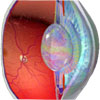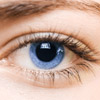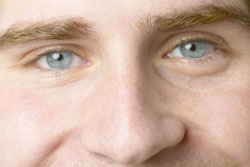- What is diabetic retinopathy?
- Prevalence
- How diabetic retinopathy affects vision
- Impact of diabetic retinopathy
- Screening for diabetic retinopathy
- Diabetes control in individuals with diabetic retinopathy
- Treatment
What is diabetic retinopathy?
Diabetic retinopathy, also called diabetic eye disease, refers to a group of eye diseases which affect individuals with type 1 and type 2 diabetes mellitus, and occasionally individuals with pre-diabetes metabolic abnormalities (e.g. as in metabolic syndrome). The eye diseases which diabetic retinopathy encompasses are all characterised by the abnormal growth of microscopic blood vessels (called neovascularisation in the eye’s retina (the light sensing layer of the eye) and complications arising from that. Diabetic retinopathy is the most common of all diabetic eye diseases and typically affects both eyes. It is a severe condition which may cause vision loss and is a leading cause of blindness in working age adults.
 |
For more information about the different parts of the eye and how they work, see The Eye and Vision. |
The abnormal blood vessel growth which characterises diabetic retinopathy occurs as a complication of diabetes (either type 1 or type 2). The likelihood of a diabetic developing retinopathy increases with duration of diabetes; the longer an individual has had diabetes, the more likely they are to develop retinopathy. The severity of glucose metabolism abnormalities also affects the likelihood of diabetes, and individuals with poorly controlled diabetes are more likely to develop retinopathy than those who control their diabetes, for example through diet and exercise and use of medications.
Abnormalities in glucose metabolism and retinopathy share many biochemical pathways, meaning that the chemical reactions which occur in the body and cause abnormalities in glucose metabolism, also play a role in abnormal blood vessel growth in the retina (the characteristic feature of diabetic retinopathy). Chronic hyperglycaemia (high blood sugar) is accepted as the most common pathway through which diabetic retinopathy develops. The development of different types of retinopathy is linked by many pathways to glucose metabolism.
Diabetic retinopathy may be further classified as:
- Non-proliferative diabetic retinopathy;
- Proliferative diabetic retinopathy;
- Diabetic macular oedema;
- Ischaemic maculopathy.
 |
For more information about how the different types of diabetic retinopathy are diagnosed, videos and more, see Diabetic Retinopathy. |
Non-proliferative diabetic retinopathy
Non-proliferative diabetic retinopathy, previously called background retinopathy, is early stage diabetic retinopathy. It progresses from mild to moderate to severe.
It is initially characterised by microaneurysms (microscopic enlargement of a blood vessel causing the formation of a sac in the blood vessel wall) and bleeding in the retina. As the disease progresses hard exudates (hard deposits which form from blood which leaks in the retina), abnormal changes to the blood vessel in the retina and bleeding from the veins in the retina may occur. The vascular changes lead to retinal ischaemia (lack of blood flow to the retina) which may trigger neovascularisation (abnormal blood vessel growth) in the retina and progression to proliferative diabetic retinopathy.
 |
For more information, see Non-proliferative Diabetic Retinopathy. |
Proliferative diabetic retinopathy
Proliferative diabetic retinopathy is characterised by abnormal neovascularisation and the growth of fibres in the retina and surrounding vitreous fluid. These changes occur due to insufficient blood flow to the retina. New blood vessels may grow on the optic disc (the eye’s nerve centre) or elsewhere in the eye and leak in the retina or vitreous fluid, causing spots of blood in the eye which block vision.
Treatments aim to reduce progression of abnormal changes to the eye’s blood vessels and prevent future vision loss. Early treatment is essential as current treatments for proliferative retinopathy are effective in preventing future vision loos but cannot restore vision which is already lost.
 |
For more information, see Proliferative Diabetic Retinopathy. |
Diabetic macular oedema
Diabetic macular oedema is characterised by the leaking of fluid into the eye’s macula (the section of the eye which enables clear, sharp vision) causing blurred vision and vision loss. It is the primary cause of vision loss from diabetic retinopathy and occurs as a result of vessel damage in non-proliferative or proliferative diabetic retinopathy.
The likelihood of developing diabetic macular oedema increases with the progression of non-proliferative diabetic retinopathy. It is most likely when the condition progresses to proliferative retinopathy. However, it can occur at any stage, including in the early stages of non-proliferative retinopathy.
 |
For more information, see Diabetic Macular Oedema. |
Ischaemic maculopathy
Ischaemic maculopathy is an untreatable form of diabetic retinopathy. Most individuals with ischaemic maculopathy also have some degree of macular oedema. It occurs when abnormal blood vessel growth in the retina, due to diabetes, causes capillary loss (a reduction in the number of tiny blood vessels) in the macula. This restricts blood flow to the macula causing ischaemia.
In the early stages ischaemic maculopathy causes blurred vision. As the disease progresses and causes more extensive capillary loss, vision loss occurs.
 |
For more information, see Ischaemic Maculopathy. |
Other eye disorders
Diabetes is also associated with a higher risk of other eye conditions which do not fall under the banner of diabetic retinopathy. These include:
- Cataract, which typically develops earlier and progresses more rapidly in individuals with diabetes compared to those who do not have diabetes;
- Primary, open angle glaucoma, which is more prevalent amongst diabetics compared to the general population.
Prevalence
Diabetic retinopathy is amongst the most common complications of diabetes. An estimated 25–44% of diabetics have some degree of diabetic retinopathy at any given time. Studies of diabetic retinopathy in Australia, where 8% of men and 6.8% of women are diabetic, have reported that between 25% and 35% of the diabetic population is affected by retinopathy. Prevalence is higher in older populations. Aboriginal Australians are twice as likely to develop retinopathy compared to non-Aboriginal Australians. Based on these figures, it is estimated that 300,000 Australians have diabetic retinopathy, of which 65,000 have sight-threatening diabetic retinopathy.
The prevalence of retinopathy amongst diabetics increases with progression of diabetes (worsening of the metabolic abnormalities which characterise the condition) and duration since diabetes onset. At the time of diagnosis, 6% of diabetics have some evidence of retinopathy. After 10 years diabetes duration 7% of patients have evidence of retinopathy and after 25 years some 90% will be affected by retinopathy of varying degrees. Evidence of retinopathy is almost universal amongst type 1 diabetics after 20 years duration and amongst type 2 diabetics 30 years after onset.
Worldwide, diabetes affects 150 million individuals and global prevalence is expected to exceed 200 million by 2025. Diabetic retinopathy is also a leading cause of visual impairment and blindness. It is the primary cause of blindness amongst working age people in theUnited States.
How diabetic retinopathy affects vision

The vision changes which occur may include:
- Not being able to see as well (decreased visual acuity);
- Not being able to see as clearly or having blurred vision (decreased central vision);
- Altered depth perception;
- Altered contrast and colour sensitivity;
- Altered visual field;
- Seeing differently with one eye compared to the other (bilateral disparity).
Individuals who experience visual changes as a result of diabetic retinopathy report these changes to be severe consequences of diabetes. When diagnosed with retinopathy, diabetics may experience shock and fear because of the potential for vision loss, and uncertainty about when it may occur. Because of the loss of independence they expect to accompany blindness, some diabetics perceive vision loss to have more serious consequences than other complications of diabetes, including serious consequences such as limb amputation. On average, diabetics perceive the consequences of diabetic retinopathy to be equally severe as the consequences of amputation.
Impact of diabetic retinopathy
Diabetic retinopathy significantly and negatively affects an individual’s functional ability and quality of life (QoL). Detrimental effects on QoL are particularly likely when vision loss and/or blindness occur. These effects are important to consider when determining how best to treat diabetes and associated retinopathy, as well as when assessing the effectiveness of various treatments. Effective treatments should ideally improve functional ability and quality of life for an individual, as well as preventing further eye damage and vision loss. However, there is a lack of research about the QoL impact of diabetic retinopathy and the effectiveness of various treatments in improving QoL.
Quality of life deteriorates in relation to the severity of visual impairment. Having vision-threatening diabetic retinopathy is also associated with reduced QoL compared to disease which does not threaten sight. However, reductions in QoL are experienced even in the mild-moderate stages of the disease when vision is unaffected. The impact of diabetic retinopathy on QoL may be reduced (but not eliminated) with treatment, even if the treatment does not improve vision. However, treatments including comprehensive diabetes care and lifelong changes to diet and exercise regimes can also have significant adverse impacts on QoL for some diabetics
Similar to other vision-threatening conditions (e.g. age-related macular degeneration); reductions in QoL associated with diabetic retinopathy are correlated with the extent of visual impairment. The worse a person’s vision the greater the impact on QoL the disease has. Diabetic retinopathy can negatively impact on a person’s functioning, for example by making reading and driving at night difficult, regardless of severity. Diabetic retinopathy may have adverse QoL effects before vision changes occur, which arise because of anxiety regarding the future, the diagnosis and treatment.
Physical functioning and role limitations

Vision loss associated with diabetic retinopathy can reduce an individual’s physical functioning and mobility and place limitations on their roles in life. Vision loss prevents them from performing many tasks previously taken for granted. Diabetics with retinopathy report feeling dependent on others to perform tasks which they were previously able to perform independently, and some perceive that their helpers may become tired of helping over time.
Mobility may be affected if visual loss affects the person’s ability to drive. Driving is the most frequently affected ability in individuals with diabetic retinopathy. Diabetics who stop driving due to retinopathy often rely on friends or family members to transport them. However, relying on others for transport can be a demoralising experience, and in one study some people reported that asking others for help was so demoralising that they would sometimes forego an activity to avoid needing to ask for help.
Daily necessities such as cooking may become difficult for a person who is unable to see well enough to find ingredients, or unable to drive to purchase groceries. Diabetics with vision loss due to retinopathy may also experience difficulty reading street signs and filling in forms. They may be prevented from performing simple home maintenance tasks (e.g. tightening a screw), daily self-care tasks (e.g. getting dressed) and housekeeping. This may create a financial burden for some.
Ability to work
Diabetic retinopathy may also impact on a patient’s workforce participation. In particular, vision loss associated with diabetic retinopathy may prevent individuals from working in careers which depend on high acuity vision such as surgery, driving, or professions which involve reading or using a computer.
Participation in social life and leisure activities
Diabetic retinopathy can also affect an individual’s social functioning and leisure activities. Reading is a popular leisure activity and losing vision due to diabetic retinopathy may prevent a person reading. The ability to engage in sports and leisure activities may also be impaired. For example in one study a diabetic with retinopathy reported that vision loss prevented him from fishing, as he was unable to see clearly enough to tie knots. Leisure activities such as sewing and other hobbies which require high-acuity vision may also be affected. Ability to attend social functions and visit friends may be affected if the person’s mobility is affected, for example because they are no longer able to drive.
Ability to perform diabetes care activities
Vision loss from diabetic retinopathy may also adversely affect a person’s ability to perform diabetes care activities, including performing exercise, adhering to a diabetic diet, administering insulin injections and/or performing blood tests. For example, an individual who has lost vision due to retinopathy may not be able to prepare an insulin injection, place their blood correctly on a glucometer (a machine which measure blood sugar levels), or read the result of a glucometer test while they are experiencing vision symptoms.
Impaired vision may make exercise more difficult, for example in someone who is no longer able to drive to a sporting facility, or unable to see well enough to play a sport like tennis. Fear of retinal detachment, which may occur with high impact exercise, may also prevent a person with retinopathy from exercising.
Adhering to a diabetic diet may also be complicated by visual symptoms of diabetic retinopathy. The inability to drive may reduce access to food because the person can no longer easily get to the supermarket. Diabetics with retinopathy have also reported difficulty reading nutritional content labels in order to analyse the suitability of a particular type of food in their diet. They may be forced to rely on strangers to help them read the labels in supermarkets.
Screening for diabetic retinopathy

Regular screening is highly cost effective and has been shown to reduce the risk of vision loss from retinopathy by 95%. However, about 1 in 4 Australian diabetics do not receive proper screening.
Screening for diabetic retinopathy should involve:
- A visual acuity test;
- Examination of the eyes for signs of vessel damage by slit lamp biomicroscopy with dilated pupils.
Using slit lamp biomicroscopy, the doctor examining your eyes may be able to identify to following features of retinopathy:
- Abnormalities in the small blood vessels of the retina;
- Bleeding/leakage from these small blood vessels;
- Microaneurysms;
- Soft exudates; that is, areas where fluid from the leaking blood vessels has accumulated;
- Venous bleeding;
- Neovascularisation;
- Growth of fibrous tissues.
The features differ depending on the type of retinopathy.
Diabetes screening in undiagnosed individuals
Some people may not have been diagnosed with diabetes at the time of their diabetic retinopathy diagnosis. For these individuals it is very important to see a doctor for diabetes assessment and management as, if the diabetes is left untreated, diabetic retinopathy will worsen more quickly. The eye specialist who diagnoses diabetic retinopathy can provide you a referral letter to take to your doctor.
Grading diabetic retinopathy
If there is evidence of retinopathy, the doctor will need to assess its features to determine which type of diabetic retinopathy you have and the severity of the condition. This process is called grading and is conducted according to the Wisconsin System recommended by the Australian National Health and Medical Research Council. Grading is important because the management of retinopathy differs depending on severity and type.
Emergency (same day) treatment is required for individuals with severe proliferative retinopathy and in individuals who have experienced sudden vision loss. If neovascularisation of the retina, bleeding into the vitreous fluid or rubeosis iridis (neovascularisation affecting the iris) is detected on the eye examination, you will need to see a doctor for treatment within 1 week. If proliferative retinopathy or macular oedema is suspected, you will need to see a specialist for assessment and treatment within four weeks.
If your slit lamp biomicroscopy examination reveals evidence of retinopathy, you may need to have further tests and examinations performed. These include:
- Stereoscopic fundus photography: A technique in which high-resolution photographs of the eye are examined for evidence of retinopathy;
- Fluorescein angiogram: A test in which fluorescent dye is injected into a vein prior to eye examination. The fluorescent dye reaches the blood vessels of the eye and enables the examiner to more easily determine if the blood vessels are leaking;
- Ophthalmoscopy: The use of a special instrument called an ophthalmoscope to view the inner layers of the eye;
- Colour contrast threshold testing;
- Computerised diabetic retinopathy grading using digital photography;
- Optical coherence tomography: A technique which uses patterns of light to generate images of the inner structure of the eye;
- Ultrasonography: A technique which uses sound waves to generate images of the inner structures of the eye;
- Tonometry: A test of pressure in the eye; and
- Investigations to determine diabetes status and control, for example a blood glucose test.
Diabetes control in individuals with diabetic retinopathy

Pharmacotherapy
Normalising metabolic abnormalities including blood pressure, blood sugar and cholesterol levels, also referred to as diabetes control, is an important goal in the treatment of retinopathy. Achieving the metabolic ranges associated with the least risk of retinopathy may require more intensive treatment than standard diabetes control.
In diabetic retinopathy, diabetes treatment should aim to attain the following metabolic values:
- Glycaemic control: HbA1c (blood sugar) levels < 7%, but > 6%;
- Blood pressure: 140/80 mm HG or lower;
- High density cholesterol: > 4 mmol/L;
- Low density cholesterol: < 2 mmol/L.
Research suggests that optimal diabetes control through intensive treatment slows progression of retinopathy. For example, one study reported that intensive diabetes treatment reduced the risk of an individual developing retinopathy by 17% over 10 years. Individuals on intensive diabetes treatment were also 29% less likely to require laser surgery to treat retinopathy and 16% less likely to be declared legally blind after 10 years, compared to those who received normal treatment. The development and progression of retinopathic changes reduced by up to 54% in type 1 and 25% in type 2 diabetic patients who received tight glucose control in one study.
There is also evidence that blood pressure reducing therapies reduce progression of retinopathy. There is no evidence that controlling cholesterol levels with medicines called statins reduces retinopathy risk.
Note, however, that there are conflicting results and some studies have shown no improvement in retinopathy with tight diabetes control.
Lifestyle measures
Lifestyle changes, in particular adherence to a diabetic diet and regular exercise, are also important components of diabetes control.
A diabetic diet is based on the consumption of limited amounts of fat, low glycaemic-index (GI) fruits and vegetables, whole grains, low fat dairy and proteins. It should incorporate foods from each of these groups, every day. Sugar intake is reduced and ideally all added sugar is removed from the diet, along with sugary treats such as soft drinks, cakes and sweets. Alcohol should be avoided. Alcohol consumption makes adherence to a diabetic diet extremely difficult, because it contains a lot of calories with minimal nutritional content.
Exercise may play a role in restoring glucose levels to normal and improving glucose metabolism. A physical activity plan is an important component of diabetes management. Studies of exercise regimes involving 3–4 sessions per week of moderate intensity exercise for 30–60 minutes have demonstrated these exercise patterns improve markers of diabetes. Physical activity is also associated with lower blood pressure and cholesterol levels and a reduced risk of obesity. It may further reduce the risk of retinopathy through these mechanisms.
Note, however, that exercise is associated with risks for some diabetics including those with cardiovascular risk factors and poorly controlled type 1 diabetes. Always plan your exercise with the advice of your doctor and ensure you are screened for risk factors that may be exacerbated by exercise (e.g. heart problems) prior to starting your physical activity program. When exercising, be aware:
- That proper hydration is essential whilst exercising, particularly in hot weather. Drink plenty of water before and during exercise;
- That all exercise sessions should involve an adequate warm up and cool down period (5–10 minutes) involving low intensity exercise;
- Of the need to take precautionary foot care measures to avoid blisters and foot damage. Appropriate footwear should always be worn whilst exercising. You should check your feet for blisters and other damage following each exercise session;
- That high impact exercise can strain weak blood vessels in the eye and increase the risk of bleeding. Avoid high impact exercise if you have proliferative retinopathy.
If you have type 1 diabetes, you should also:
- Avoid exercise if your fasting blood glucose is > 250 mg/dl and you have ketosis (a condition in which your body burns fat due to lack of glucose as an energy source);
- Exercise with caution if glucose levels are > 300 mg/dl;
- Take note of your glycaemic response to various forms of exercise, in order to determine when changes in food intake or insulin dose are required with exercise;
- Consume carbohydrate-rich foods as necessary to avoid hypoglycaemia. Such foods should always be on hand during exercise.
Developing an individualised diabetes control plan
Some diabetics with retinopathy find it more difficult to adopt lifestyle changes than others. Modifying diet and exercise and/or taking multiple medications for diabetes control each day may adversely affect QoL for some diabetics. It is important to consider the challenges which lifestyle changes may present for you and let your doctor know about these. In that way your doctor can determine the best plan for you, one which allows you to control your diabetes but has the least possible negative affect on your QoL.
Treatment

A range of treatments for proliferative diabetic retinopathy and macular oedema are effective in reducing progression of the disease and vision loss; however, they have only limited ability to restore vision once it is lost. These include:
- Scatter (panretinal) laser photocoagulation surgery, which involves directing laser beams into the retina. It may be used in early or late stage proliferative retinopathy to close leaking blood vessels and prevent further neovascularisation.This treatment reduces the risk of severe and moderate vision loss by up to 50%;
- Macula laser surgery is a treatment option for diabetics with macular oedema. It involves directing laser beams into areas of the macula to close leaking blood vessels. It reduces the risk of vision loss by up to 50%. However, repeat treatment is often necessary and there is a risk of vision loss from other causes associated with the surgery;
- Vitrectomy, which is the removal of blood from the eye, is used to treat severe proliferative retinopathy with bleeding in the vitreous. It may be particularly useful in people who also have macular oedema. Vitrectomy is 90% effective in either stabilising vision loss or improving vision. Note, however, that this treatment is usually reserved for individuals who fail to respond to aggressive laser surgery;
- Intravitreal anti-vascular endothelial growth factor medicines including pegaptanib, ranibizumab and bevacizumab are emerging as promising methods of treating proliferative retinopathy and macular oedema. These medicines work by impairing the natural processes which cause new blood vessel growth. This therapy involves having the medicine injected into your eye. It reduces the need for laser surgery and may improve vision in some individuals with proliferative retinopathy. It may also improve visual acuity and reduce visual deterioration in individuals with macular oedema. However, these medicines are not currently recommended for routine use in the treatment of diabetic retinopathy;
- Intravitreal steroids, which are steroid injections in the eye, may be used to treat individuals with macular oedema who fail to respond to laser surgery and those with macular oedema characterised by extensive hard exudate deposits. Intravitreal steroid injections have been shown to reduce progression and may improve visual acuity by up to 56%. However, the treatment is associated with significant adverse effects;
- Intravenous monoclonal anti-tumour necrosis factor, a medicine used in the treatment of other eye disorders, inflammatory arthritis and other conditions, has been trialled as therapy for macular oedema. Results from one small study are promising and indicate further research on the use of monoclonal anti-tumour necrosis factors in the treatment of macular oedema is warranted. However, the therapy is not currently recommended.
Support services for patients with severe visual deterioration
If you have experienced irreversible visual loss, talk to your doctor about referral to support services. You may be able to register as blind or partially sighted, which will enable greater access to support services. You should also consider talking to your doctor about a referral for counselling and other services if you have difficulty coping with diabetic retinopathy and the changes it brings to your life.
References
- National Health and Medical Research Council. Guidelines for the management of diabetic retinopathy. 2008. [cited 2011, Feb 28] [URL Link]
- National Eye Institute. Facts About Diabetic Retinopathy. 2009. [cited 2011, Feb 22] [URL Link]
- National Institutes of Health. Diabetic Retinopathy. 2010. [cited 2011, Feb 22] [URL Link]
- Tabandeh H, Goldberg M, The retina in Systemic Disease: A colour manual of Ophthalmoscopy.Thieme Publishers. 2010. pp91-108. [cited 2011, Mar 10] [Book]
- Watkins PJ. Retinopathy. BMJ. 2003; 326: 924-6. [Full Text]
- Scanlon PH. Stage M1: Maculopathy. Chapter 6 in A Practical Manual of Diabetic Retinopathy. Eds PH Scanlon, C Wilkinson, S Aldington, D Matthews. Wiley Blackwell. 2009. p74. [Book]
- Ockrim Z, Yorston D. Managing Diabetic Retinopathy. BMJ Clinical Review. 2010; 341: 930-5. [Abstract]
- Coyne KS, Margolis MK, Kennedy-Martin T, et al. The impact of diabetic retinopathy: perspectives from patient focus-groups. Fam Prac. 2004; 21(4): 447-53. [Abstract]
- Spurling G, Askew D, Jackson C. Retinopathy- Screening Recommendations. Aust Fam Phys. 2009; 30(10): 780-3. [Full Text]
- Fenwick EK, Pesudovs K, Rees G, et al. The impact of diabetic retinopathy: understanding the patient’s perspective. Br J Ophthalmol. 2011; 95: 774-782. [Abstract]
- Huang ES, Brown SES, Ewigman BG. Patients perceptions of Quality of life with diabetes related complications and treatments. Diabetes care. 2007; 30(10): 2478-2483. [Abstract | Full Text]
- Brown MM, Briwn GC, Sharma S, et al. Quality of life with visual acuity loss from diabetic retinopathy and age-related macular degeneration. Arch Oppthalmol. 2002; 120: 481-4. [Full Text]
- Sharma, S. Oliver-Fernandez A, Weic L. et al. The impact of diabetic retinopathy on health related quality of life. Cur Op Ophthalmol. 2005; 16(3): 155-9. [Abstract]
- Fong DS, Aiello L, Gardner T, et al. Diabetic Retinopathy. Diabetes Care. 2003; 26(S1): S99-102. [Full Text]
- Wu G, Management of proliferative diabetic retinopathy. Chap 9. Diabetic Retinopathy- The Essentials. 2010. pp122-137. [cited 2011, Mar 10] [Book]
- Onofrey BE, Skorin L, Holdeman NR. Diabetic Retinopathy. Ocular therapeutics handbook: a clinical manual. 2005. pp520-526. [cited 2011, March 10] [Book]
- American Diabetes Association. Physical Activity/Exercise and Diabetes. Diabetes Care. 2004; 27(s1): s58-s62. [Full Text]
- American Diabetes Association. Diabetic Diet. 2011. [cited July 19 2011] Available from: [URL Link]
- Viswanath, K, McGavin DDM. Diabetic Retinopathy Clinical Management and Findings. Com Eye Health. 2003; 46(16): 21-4. [Full text]
- American Academyof Ophthalmology Retina/Vitreous Panel, Preferred Practice Patterns Committee. Diabetic retinopathy. San Francisco(CA): American Academyof Ophthalmology (AAO); 2008. [cited 2011, Feb 28] [URL Link].
- Sfikakis PP, Markomichelakis N, Theodossiadis GP, et al. Regression of sight-threatening macular edema in type 2 diabetes following treatment with the anti-tumor necrosis factor monoclonal antibody infliximab. Diabetes Care. 2005; 28(2): 445-7. [Abstract | Full Text]
- International Council of Ophthalmology. Diabetic Retinopathy (Initial and Follow up evaluation). 2010. [URL Link]
All content and media on the HealthEngine Blog is created and published online for informational purposes only. It is not intended to be a substitute for professional medical advice and should not be relied on as health or personal advice. Always seek the guidance of your doctor or other qualified health professional with any questions you may have regarding your health or a medical condition. Never disregard the advice of a medical professional, or delay in seeking it because of something you have read on this Website. If you think you may have a medical emergency, call your doctor, go to the nearest hospital emergency department, or call the emergency services immediately.








